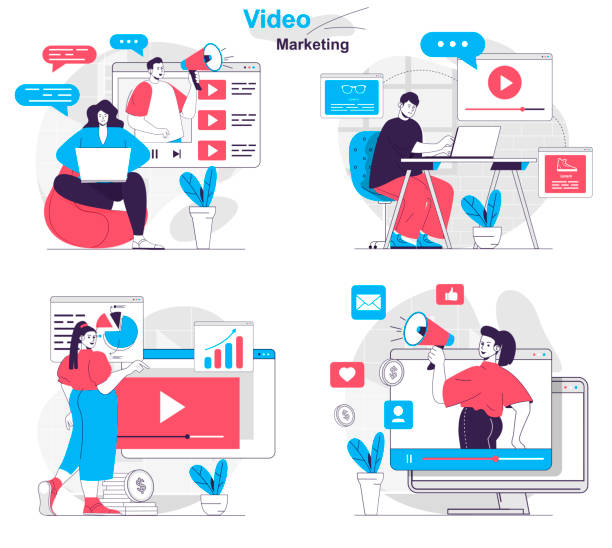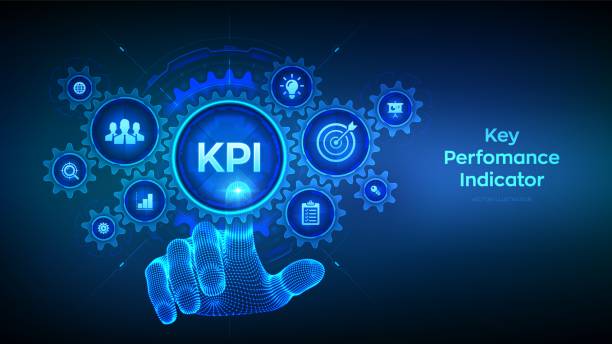The Importance of Speed in the Modern Web World

In the current digital age, where users seek instant information and seamless experiences, website loading speed is not just an advantage but a critical necessity.
#Website speed, #SEO, and #user experience are closely intertwined.
Studies have shown that even a few seconds of delay in page loading can lead to a significant loss of visitors.
Today’s users are impatient and have high expectations for website performance.
This further emphasizes the importance of fast website design.
A slow-loading website not only harms your business’s reputation and credibility but also directly negatively impacts your conversion rate and profitability.
Therefore, investing in speed optimization and ensuring optimal website performance is a strategic step for any online business.
Search Engine Optimization (SEO) is also highly dependent on speed; search engines like Google rank faster websites higher because they offer a better user experience.
Thus, if you are looking to increase traffic, improve conversion rates, and achieve sustainable success in the online space, your website speed should be a top priority.
This is a specialized and essential topic for developers and business owners.
Is your online sales not as expected? With RasaWeb, permanently solve the problem of low sales and poor user experience!
✅ Increase visitor-to-customer conversion rate
✅ Create an enjoyable user experience and boost customer trust
⚡ Act now to receive a free consultation!
Key Factors Affecting Website Speed

To achieve fast website design, identifying and managing factors affecting loading speed is essential.
One of the most important factors is web hosting.
Choosing quality hosting with powerful servers and sufficient bandwidth is the foundation of your website’s speed.
Cheap shared hosting often has limited resources, which can lead to slow website performance.
Another critical factor is image optimization and media.
High-volume images, without proper compression, can create a heavy load on the server and user’s browser.
Using appropriate image formats like WebP and intelligent compression to reduce size without compromising quality are essential steps.
Optimized and clean coding also plays a significant role.
Uncompressed CSS, JavaScript, and HTML codes, full of empty spaces and unnecessary comments, can increase loading time.
Minification of these files and reducing HTTP requests improve site performance.
Also, using too many plugins in content management systems like WordPress can cause slowness; choosing lightweight plugins and only using essential ones is recommended.
These analytical and educational discussions are vital for anyone looking to improve their website’s performance.
Tools and Techniques for Website Speed Optimization

Achieving fast website design requires the use of specialized tools and techniques.
One of the first steps is to use speed analysis tools such as Google PageSpeed Insights, GTmetrix, and Lighthouse.
These tools identify your website’s weaknesses and offer suggestions for improvement.
After identifying problems, there are several techniques that can be employed.
Caching is one of the most effective methods; by storing a copy of web pages in the user’s browser or on the server, subsequent loads are faster.
Using a CDN (Content Delivery Network) is also very beneficial for websites with global audiences, as it delivers content from the server closest to the user.
GZIP compression for text files like HTML, CSS, and JavaScript also significantly reduces data volume.
Database optimization, cleaning up unnecessary code, and lazy loading for images and videos, which are only loaded when the user scrolls to them, are other important techniques.
These approaches provide a comprehensive guide to improving site speed.
Table 1: Key Speed Optimization Tools and Methods
| Tool/Method | Main Use | Description |
|---|---|---|
| Google PageSpeed Insights | Speed Analysis and Scoring | Provides Core Web Vitals scores and improvement suggestions. |
| Caching | Content Storage for Faster Loading | Reduces server requests and increases speed. |
| CDN (Content Delivery Network) | Global Content Distribution | Reduces response time for distant users. |
| Image Optimization | Image Size Reduction | Uses modern formats and compression. |
The Impact of Speed on User Experience and SEO

Website speed directly impacts not only user satisfaction but also your ranking in search engines.
From a user experience (UX) perspective, a slow website can lead to frustration, premature page abandonment, and even loss of customers.
Today’s users have high expectations and cannot wait for pages to load.
Statistics show that a high percentage of users abandon websites that take more than 3 seconds to load.
This directly affects and increases the bounce rate.
On the other hand, search engines like Google consider loading speed as an important ranking factor.
Core Web Vitals, a set of user experience metrics introduced by Google, lists page loading speed as one of its primary components.
Websites that load faster have a greater chance of achieving higher rankings in search results, which means increased organic traffic and greater visibility.
Therefore, striving for fast website design is an investment in improving both SEO and UX aspects, ultimately contributing to your online success.
This is an analytical and explanatory topic that illuminates the importance of speed optimization from two critical perspectives.
Are you dissatisfied with your e-commerce site’s low sales?
RasaWeb is your solution for having a professional and high-selling e-commerce site.
✅ Significant increase in sales and revenue
✅ Easy and enjoyable shopping experience for customers
⚡ Get a free consultation from RasaWeb now!
Choosing the Right Platform for Fast Website Design

Choosing the right platform for website creation plays a key role in achieving fast website design.
Various platforms such as WordPress, Joomla, Drupal, and web development frameworks like React and Angular, or even manual coding, each have their own features, advantages, and disadvantages.
WordPress is very popular due to its ease of use and extensive ecosystem of plugins and themes; however, it should be noted that choosing heavy themes or excessive use of plugins can significantly reduce its speed.
For fast website design with WordPress, selecting lightweight and optimized themes and using caching plugins is essential.
In contrast, web development frameworks offer greater flexibility and, if coded by expert developers following optimization principles, can achieve very high speeds.
This specialized guide helps you make the best decision for platform selection based on your needs and budget.
Additionally, site builders like Wix or Squarespace, while offering simplicity, typically provide less control over deep speed optimizations.
Ultimately, it doesn’t matter which platform you choose; rather, how it’s implemented and optimized for loading speed is the main determinant.
The Role of Mobile-First Approach in Loading Speed

Given the increasing number of mobile users, the Mobile-First approach is not just a design trend but a necessity for achieving fast website design.
This approach means that website design and development are done first for mobile devices and then for desktop devices.
This is important because network conditions and processing power on mobile devices are often more limited, making optimization for them more challenging.
Mobile-friendly (Responsive) websites, especially pages that load quickly on mobile, are preferred by search engines and achieve better rankings in search results.
Technologies like AMP (Accelerated Mobile Pages) were introduced by Google to quickly load web pages on mobile.
These pages are lighter versions of main pages that use more limited HTML and CSS codes and are loaded directly from Google’s cache.
News regarding Google algorithm updates consistently emphasizes the importance of mobile user experience.
Therefore, if you want your website to remain competitive in today’s world and provide a flawless user experience, focusing on speed and optimizing it for mobile is of high importance.
This is an educational and newsworthy aspect that cannot be overlooked.
Common Mistakes in Website Design and Ways to Avoid Them

Even with awareness of the importance of fast website design, many developers and website owners make mistakes that lead to slow website speeds.
One of the most common mistakes is lack of image optimization.
Loading images with larger dimensions than needed or in inappropriate formats severely impacts loading time.
Another mistake is the excessive use of plugins or heavy JavaScript scripts, which can cause conflicts and slow down the site.
Not using caching is also a common error; without caching, every time a user visits the website, the server must load all content from scratch.
Choosing unsuitable hosting and disregarding server specifications, especially during traffic spikes, can lead to a drop in speed.
Additionally, lacking a responsive design and mobile-friendliness can lead to a poor user experience and consequently, overall speed reduction.
The question arises: why, despite all this information, do these mistakes still occur? Perhaps due to a lack of full awareness or haste in the development process.
However, by following the correct guidelines and avoiding these pitfalls, optimal performance can be achieved.
Table 2: Common Web Design Mistakes and Their Solutions
| Common Mistake | Explanation | Solution |
|---|---|---|
| Lack of Image Optimization | High-volume images and unsuitable dimensions. | Compression, format change (WebP), Lazy Loading. |
| Excessive Use of Plugins/Code | Too many plugins or heavy JavaScript codes. | Use essential and lightweight plugins, code Minification. |
| Unsuitable Hosting | Slow servers or insufficient resources. | Choose quality hosting proportional to traffic. |
| Not Using Caching | Full content loading from the server every time. | Enable server-side and browser caching. |
Measuring and Monitoring Website Speed Performance

After implementing fast website design techniques, the next critical step is continuous measurement and monitoring of website performance.
This allows you to evaluate the effectiveness of changes and identify potential issues before they impact users.
Various tools are available for this purpose.
In addition to Google PageSpeed Insights, tools like GTmetrix and Lighthouse (built into Chrome Developer Tools) provide deeper insights into loading time, network requests, and overall website performance.
These tools offer detailed reports and performance scores, including specifics such as Time to First Byte (TTFB), First Contentful Paint (FCP), and Largest Contentful Paint (LCP).
Furthermore, continuous monitoring using tools like Google Search Console, which gathers Core Web Vitals data directly from real user experiences, is very important.
This section of specialized and educational topics shows you how to actively manage and improve your website’s speed, ensuring that your investment in website optimization yields desired results.
Are you disappointed with your e-commerce site’s low conversion rate? RasaWeb transforms your e-commerce site into a powerful tool for attracting and converting customers!
✅ Significant increase in visitor-to-buyer conversion rate
✅ Unparalleled user experience to boost customer satisfaction and loyalty⚡ Get a free consultation from RasaWeb!
The Future of Web Speed and Emerging Technologies

The web world is constantly evolving, and these developments also impact how fast website design is achieved.
Emerging technologies like HTTP/3, a new internet protocol based on QUIC, promise faster and more reliable communications.
This protocol can significantly increase website loading speed by reducing latency and improving packet loss handling.
Additionally, WebAssembly allows developers to execute high-performance code directly in the browser, providing high potential for complex and interactive web applications.
This technology can help build websites with desktop-like capabilities and high speed.
The concept of Edge Computing is also emerging, which moves content to servers closer to the user to reduce latency.
This analytical and engaging approach to the future of the web shows that speed optimization is an endless journey, with new technologies constantly emerging to improve user experience and website performance.
Monitoring these changes and updating knowledge and skills is essential to maintain competitiveness in the online space.
Sustaining Website Speed and Maintenance

Fast website design is not a one-time project but a continuous process requiring ongoing maintenance.
After the initial optimizations, sustaining website speed is of paramount importance.
This includes regular updates to the Content Management System (CMS), plugins, themes, and all server-side software.
Updates not only improve security but often include performance optimizations as well.
Regular performance monitoring using the tools introduced in previous sections helps you quickly identify and resolve any speed drops.
Periodic database cleanup of redundant and unused information, optimization of new content (like freshly uploaded images and videos), and efficient management of JavaScript and CSS files whenever new content is added are other essential measures.
Additionally, reviewing and deleting plugins or codes that are no longer needed can help maintain the website’s lightness and speed.
This explanatory and guiding section emphasizes that maintaining website speed is a long-term commitment that requires continuous dedication and attention to ensure your website always provides the best user experience and maintains its position in search results.
Frequently Asked Questions
| Row | Question | Answer |
|---|---|---|
| 1 | What does fast website design mean? | Fast website design means optimizing the website design and development processes so that the final result (the website) is ready for operation in the shortest possible time, while maintaining quality and efficiency. This includes using efficient tools, templates, and techniques. |
| 2 | Why is speed important in website design? | Speed in website design is important because customers usually have an immediate need for an online presence. Also, longer projects can be more costly and delay business opportunities. Faster website delivery contributes to customer satisfaction and competitive advantage. |
| 3 | What tools help in fast website design? | Content Management Systems (CMS) such as WordPress, Joomla, or Drupal, the use of CSS frameworks like Bootstrap or Tailwind CSS, page builders like Elementor or Visual Composer, and Rapid Application Development (RAD) tools help in fast design. |
| 4 | Does using ready-made templates affect fast design? | Yes, using ready-made and standard templates has a very significant impact on fast design. These templates are pre-designed and only require customization of content, color schemes, and images, which drastically reduces development time. |
| 5 | What is the role of CMS (Content Management System) in fast website design? | CMSs play a key role in accelerating the website design and development process due to providing a graphical user interface, no need for deep coding for most operations, the availability of ready-made plugins and themes, and easy content editing capabilities. |
| 6 | Does high design speed reduce the final website quality? | Not necessarily. If standard and optimized methods, tools, and templates are used, a high-quality website can be designed in a short time. The knowledge and experience of the design team are also very effective in maintaining quality. |
| 7 | What tips are important for accelerating the client communication process in website design? | Having a transparent and clear process for requirements gathering, using standard forms for content submission, setting realistic deadlines, and holding focused and efficient meetings can accelerate client communication. |
| 8 | What is the effect of image optimization on website loading speed after design? | Image optimization (volume compression, use of appropriate formats like WebP) reduces the overall size of website pages. This reduction in size helps browsers download and display pages faster, which improves the user experience. |
| 9 | Does suitable hosting affect the final website speed after design? | Yes, high-quality hosting with powerful servers, sufficient resources, and adequate bandwidth plays a very important role in website loading speed after design. Even an optimized website will perform slowly on weak hosting. |
| 10 | What types of businesses is fast website design most suitable for? | Fast website design is highly suitable for small and medium-sized businesses, startups, nascent online stores, bloggers, or individuals who need an immediate and low-cost online presence. This method allows them to enter the market faster and receive feedback. |
And other services of RasaWeb Advertising Agency in the field of advertising
Smart Digital Advertising: Designed for businesses seeking customer acquisition through Google Ads management.
Smart Custom Software: A professional solution for customer acquisition focusing on SEO-driven content strategy.
Smart Google Ads: Designed for businesses looking to increase click-through rates through key page optimization.
Smart Marketing Automation: A dedicated service for increasing website traffic growth based on intelligent data analysis.
Smart Marketing Automation: A fast and efficient solution for increasing sales with a focus on attractive user interface design.
And over a hundred other services in the field of internet advertising, advertising consultation, and organizational solutions
Internet Advertising | Advertising Strategy | Advertorials
Resources
- Website Speed Optimization
- Tips for Efficient Web Design
- Fast Website Architecture
- Tools to Increase Website Speed
✅
? Are you looking to advance your business in the digital world? Rasaweb Afarin, a leading digital marketing agency, with expertise in SEO, online advertising, and fast website design, paves your path to success.
📍 Tehran, Mirdamad Street, next to Bank Markazi, Kazeroon Jonoubi Alley, Ramin Alley, No. 6


